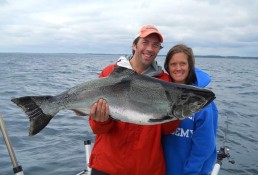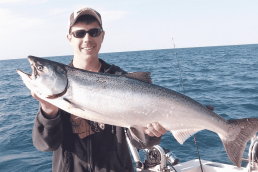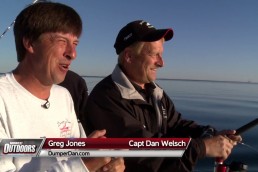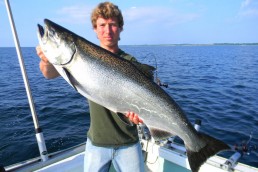The King Salmon are Coming!
SHARE THIS POST
Predicting the weather is a tough job. I remember watching a special showing why the Midwest is such a difficult region to predict weather patterns, mainly because of what the large bodies of water do to the weather in the atmosphere. If that is true, predicting when the kings are going to show up is twice a tough. I’ve spent quite a bit of time the past 30 years paying close attention to winter weather patterns and how they affect the start to the salmon fishing on the lake. When I started fishing in the early ‘70s, we were in what I call “hard winter” patterns.
I remember winters with lots of snow and late starts to spring. This usually meant that we would see kings showing up sometimes as late as late June or early July. We would fish lake trout in May and steelhead in June, but kings came later. In more recent years, ‘90s and early 2000s, we saw winter weather patterns that brought on talks of global warming. Mild temperatures and much shorter winters and early springs saw early king action heat up as early as mid-May. It’s great for early action, but sometimes it could spell trouble in late summer with warmer than normal water temperatures. The last several years had been like a yo-yo—mild one year, and harsh long winters the next. This year, looks to be an early spring, thin ice conditions, mild winter temperatures and light snow cover will make for some great early king action!
What causes the early action? My theory is that king salmon don’t migrate to the southern part of the lake like the coho salmon do. What triggers the active feeding is the water temperatures in the area. When we have long, hard, cold winters the lake’s surface cools and the cold surface water starts going deeper and deeper. The deeper the cold water column goes, the longer it takes to warm up. Transversely, if winter is mild, that cold water is fairly shallow and means water should warm quicker. The quicker the water warms up, the sooner the lake turns over and the sooner the kings become active. With the mild temperatures at the start of 2015 winter, many of us cheered our lower heat bills, but I spent my time getting my equipment ready for an early spring!
Winter looked like it was going to start early and bite us like last year, but December turned mild and slowed ice making. January gave us a week or so of a cold bite, and then it turned mild. We had decent ice for fishing, but not really thick. That means it’s time to attack my trolling equipment in anticipation of some early brown trout action and early kings! Since I fished right up until I pulled my boat this past fall, I sometimes hurry to put things away to jump into hunting mode. Now that my show season is starting to wind down, I find myself turning my attention to equipment management and tackle organization in preparation for the upcoming season.
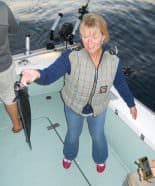
We’ve covered the off-season care for my Abu Garcia Alphamar 20LCs and the Ugly Stik GX2s, but one of the most important maintenance areas is your boat and the safety equipment. This is the perfect opportunity to repair, replace or restock the safety equipment on your boat. First, go through your life jackets. You want to look for rips, tears or damaged jackets; these should be replaced. We spend hundreds, if not thousands on fishing equipment. A good, comfortable life vest is the best investment we can make.
The next inventory is your safety signal flares. These are dated and expire every three years. Once the fish are biting, it is easy to forget about these and replacing them now is a good habit to get into.
One of my most important tasks, after all those times last season that I cut a finger or stuck a hook on my hand, I need to replenish my first aid kit. The most common items in any first aid kit always seem to disappear; those are first aid antiseptic and Band-Aids. Because my hands are in and out of the water a lot, I try to find good quality fabric Band-Aids and stock my kit with a heavy dose of them.
Are you enjoying this post?
You can be among the first to get the latest info on where to go, what to use and how to use it!
Taking a little time now getting your boat’s safety equipment in order will have you ready to do battle with those monster kings that will be appearing early this season. With any luck, I’m planning on boxing some chunky browns by early April, and with some decent spring rains, look for the kings to appear in mid to late May!
One more winter tactic is to visit your local fishing spot’s website and bookmark the fishing report pages to be able to quickly check your favorite spot for the hot action before your next outing. I recommend checking out Lake-Link.com, they have fishing report blogs on almost every body of water in the Midwest.
Capt. Lee Haasch is a charter captain out of Algoma, Wis. Capt. Lee has over 40 years of Great Lakes angling experience and has been instructing anglers for over 25 years with education seminars and timely freelance articles in outdoor publications.
Tip of the Month
USCG regulations require you to have three in-date signaling flares. You need to have both the hand held type and the type that launches. Since three must be current and not expired (it is a good idea to have all current), you can have additional flares on-board. I guess I look at it that if I were stranded and fired off and lit my flares and no one had arrived to help, having more flares is better. I keep an old kit with the extra, outdated flares and extra signaling capacity in case of an emergency. Over the years and with a couple of boats, I’ve accumulated a few extra flares. These make excellent additions to your safety kits in your truck and cars. Finally, I take the very oldest flares and use them for practice. If you have never practiced lighting off flares or shooting the 12-gauge flares this a perfect time to see how they work.
MWO
SHARE THIS POST
Did you enjoy this post?
You can be among the first to get the latest info on where to go, what to use and how to use it!
Lee Haasch
Capt. Lee Haasch is a charter captain out of Algoma, Wis., with more than 45 years of Great Lakes angling and guiding experience. Haasch has been instructing anglers for over 30 years with education seminars and timely freelance articles.
